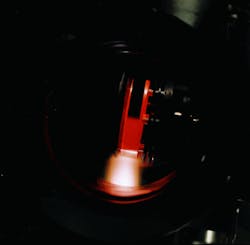Spring meetings of the Materials Research Society (MRS) tend to emphasize semiconductor and photonic applications, and last April`s meeting in San Francisco, CA, was no exception. The meeting also provided an opportunity for researchers in the pulsed laser deposition (PLD) community to celebrate the tenth anniversary of that technology`s initial application to fabrication of thin-film high-temperature superconductors.
Almost 3000 people attended the meeting, and most of the 32 symposia were well attended, according to Ronald Gibala from the University of Michigan–Ann Arbor, a vice president of MRS who also cochaired the spring meeting. Symposia on flat-panel displays, organic electroluminescent devices, and silicon front-end technology for semiconductor manufacturing were so heavily attended that they overflowed their allotted rooms, he said. Attendance at a symposium on rapid thermal and integrated semiconductor processing made the room full enough to "bulge at the seams." Even smaller, experimental symposia, such as one on biomaterials for regulating cell function, were often packed.
Topics that drew the largest crowds tended to be ones that generated high industrial interest because of exciting research with the potential to spark significant advances in the near future, Gibala said. For instance, papers on organic electroluminescent devices included innovative topics such as fabrication of multiple-color devices by photobleaching, development of highly efficient light-emitting diodes from fluorene-containing polymers, and applying polymer coatings directly onto glass and flexible substrates using an inkjet printer (see related story on p. 37).
A historical symposium on the development of semiconductor materials and devices was well attended also. Speakers included Robert Hall, who gave a first-person account of the development of semiconductor lasers at General Electric Laboratories (Schenectady, NY), and Martin Klein from Yale University (New Haven, CT), who spoke about "Einstein, Quanta, and the Beginnings of Materials Science."
The beginnings, as well as possible futures, for PLD were also explored during a symposium on advances in laser ablation of materials that included a panel session commemorating the tenth anniversary of PLD use in developing thin-film, high-temperature superconductors. First demonstrated in the mid-1960s, PLD is almost as old as the laser. In the late 1980s, however, PLD started to take on commercial importance after sharply focused, high-temperature laser energy was observed to provide the relative ease of composition control and rapidity of deposition needed to produce high-temperature superconducting films. A primary question for PLD panelists at MRS was how to extend the technique from its current focus in research markets of limited size to larger industrial markets that are now dominated by other physical deposition and annealing techniques.
In both the panel session and a technical presentation, Stephen Foltyn of Los Alamos National Laboratories (Los Alamos, NM), discussed the role of PLD in the production of high-temperature superconductors coated with yttrium barium copper oxide (YBCO). Researchers at Los Alamos prefer PLD for administering the coatings, Foltyn said (see photo). But companies that are planning to use the technology tend to feel more comfortable with established or familiar technologies than with any advantages that might accrue from trying PLD. Companies often cite the capital cost of the excimer-laser PLD system as a barrier, but the capital cost of a production-level PLD system would probably be comparable to the capital cost of current systems for electron beam evaporation, Foltyn said.
The consensus at the panel meeting seemed to be that the development of PLD from its current research focus into a strong industrial technique will require a lucrative application, such as the lithography and annealing applications that drive the market for excimer lasers in the semiconductor industry. T. Venkatesen, who pioneered the high-technology superconductor technique at the University of Maryland and subsequently started a PLD company (Neocera; Beltsville, MD), argued that the development of III-V materials such as gallium nitride (GaN) for blue-light-emitting and laser diodes may present such an opportunity for PLD.
About the Author
Hassaun A. Jones-Bey
Senior Editor and Freelance Writer
Hassaun A. Jones-Bey was a senior editor and then freelance writer for Laser Focus World.
